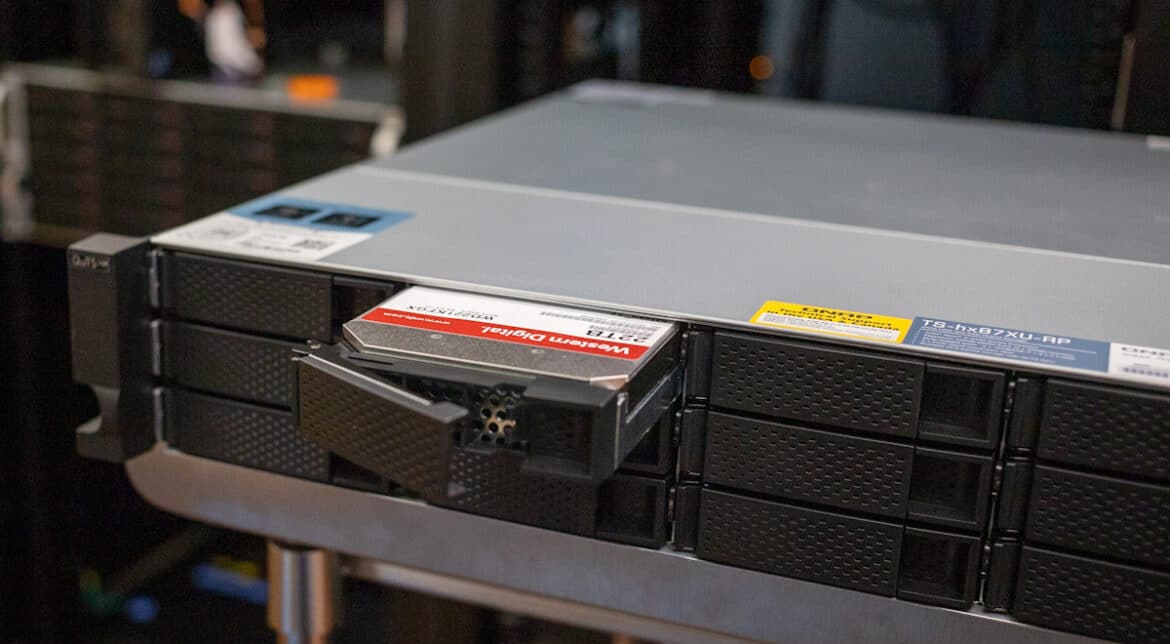QNAP has recently launched its TS-hx87XU-RP series, a line of NAS devices available in 9, 18, 22, and 30-bay models. The family of NAS integrates the Intel Xeon E-2300 series processors with 10GbE and 2.5GbE Multi-Gig connectivity and an HDD/SSD hybrid storage architecture that balances performance, capacity, and cost. Under review today is the 18-bay model. The QNAP TS-h1887XU-RP features 12x 3.5″ HDD bays in the front and 6x 2.5″ SATA bays in the back, in a 2U chassis.
QNAP has recently launched its TS-hx87XU-RP series, a line of NAS devices available in 9, 18, 22, and 30-bay models. The family of NAS integrates the Intel Xeon E-2300 series processors with 10GbE and 2.5GbE Multi-Gig connectivity and an HDD/SSD hybrid storage architecture that balances performance, capacity, and cost. Under review today is the 18-bay model. The QNAP TS-h1887XU-RP features 12x 3.5″ HDD bays in the front and 6x 2.5″ SATA bays in the back, in a 2U chassis.
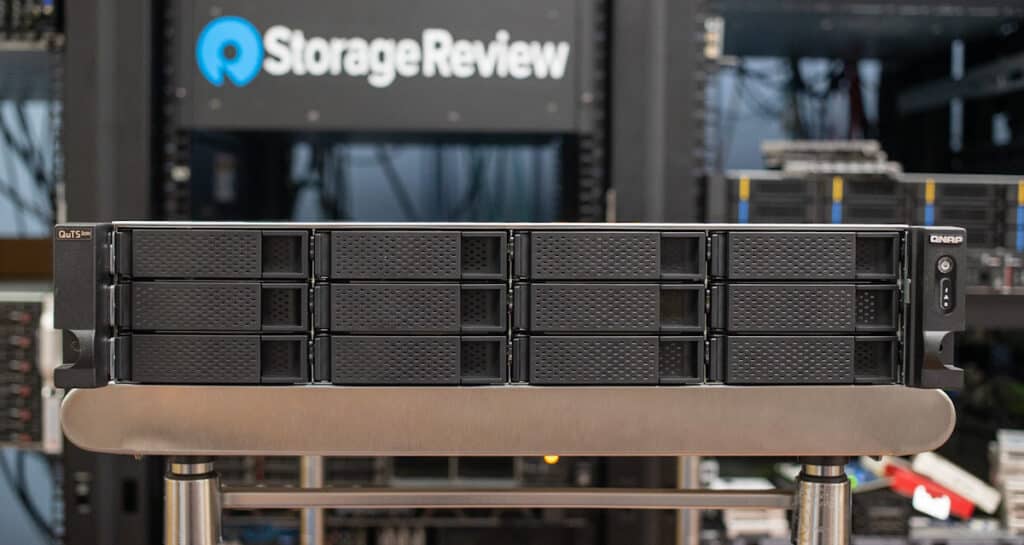
QNAP TS-h1887XU-RP Overview
These systems can run the QTS or QuTS hero operating systems. Running the ZFS-based QuTS hero operating system, the TS-hx87XU-RP series prioritizes data integrity and provides powerful data reduction, near-limitless snapshots, and up to 5 petabytes of capacity per shared folder. This makes it an ideal storage solution for businesses, with applications in file servers, virtualization servers, VDI, and backup/restore. The QTS operating system offers a performance boost if users don’t need all of the data features ZFS brings to the table.
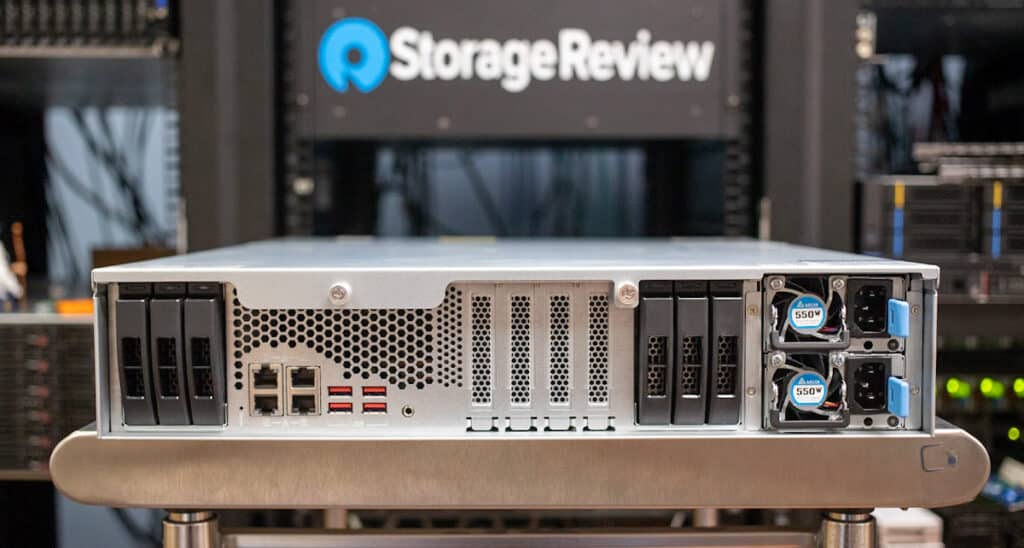
As mentioned, the TS-h1887XU-RP offers 18 total bays for storage, with 12 HDD bays in the front and 6 SSD bays in the back, they’re all SATA. QNAP does support additional storage via expansion cards should there be a need for faster flash via the optional QM2 PCIe adapter. The option to expand over PCIe offers a lot of flexibility in this build, QNA includes three available slots, 2 x Gen4 x4 and 1 x Gen 4 x8.
For connectivity, there are 2x 2.5GbE ports on board along with 2x 10GBASE-T (10G/5G/2,5G/1G/100M). Looking at DRAM there are four slots available, and this system will support 128GB total.
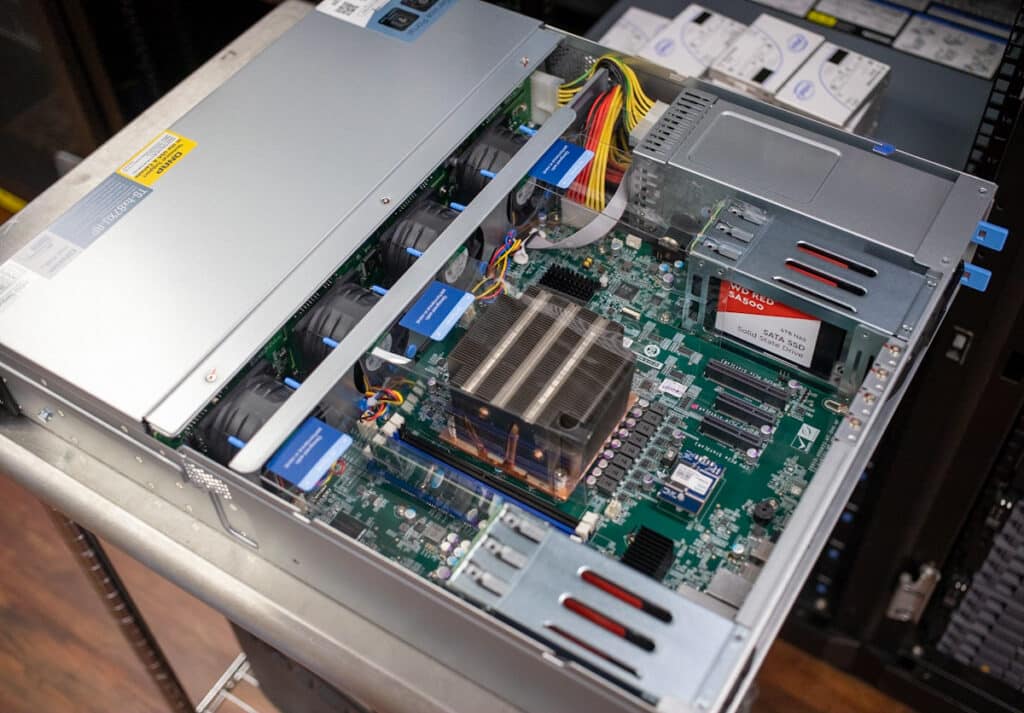
There are actually two sub-configurations of the 18-bay NAS. The TS-h1887XU-RP-E2336-32G has an Intel Xeon E-2336 CPU, 6C/12T 2.9GHz, up to 4.8GHz, 32GB ECC DDR4 (2 x 16 GB), and redundant power supply. The TS-h1887XU-RP-E2334-16G offers an Intel Xeon E-2334 CPU, 4C/8T 3.4GHz, up to 4.8GHz, 16 GB ECC DDR4 (1 x 16 GB), and redundant power supply. Our review is of the latter. At the time of publication, street price appears to be around $4,200.
QNAP TS-h1887XU-RP Specifications
| CPU | Intel Xeon E-2334 4C 8T 3.4GHz, up to 4.8GHz |
|---|---|
| CPU Architecture | 64-bit x86 |
| Floating Point Unit | Yes |
| Encryption Engine | Yes (AES-NI) |
| System Memory | 16 GB ECC DDR4 (1 x 16 GB) |
| Maximum Memory | 128GB (4 x 32 GB) |
| Memory Slot | 4 x ECC UDIMM DDR4 |
| Flash Memory | 5GB (Dual boot OS protection) |
| Drive Bay | 18 (12 x 3.5-inch SATA + 6 x 2.5-inch SATA) |
| M.2 Slot | Optional via a QM2 PCIe adapter |
| SSD Cache Acceleration Support | Yes |
| GPU pass-through | Yes |
| 2.5 Gigabit Ethernet Port (2.5G/1G/100M) | 2 (2.5G/1G/100M) |
| 10 Gigabit Ethernet Port | 2 x 10GBASE-T (10G/5G/2,5G/1G/100M) |
| PCIe Slot | 3 (2 x Gen4 x4 +1 x Gen 4 x8) |
| Form Factor | 2U Rackmount |
| Power Supply Unit | 2 x 550W PSU |
| Fan | 4 x 60mm, 12VDC |
QNAP TS-h1887XU-RP Setup and Configuration
For this review, we’re using 12x WD Red Pro 22TB HDDs for the bulk storage, and 6x WD Red 4TB SSDs for the flash volumes. Each drive group was used to create its own RAID6 storage pool from which 4 iSCSI LUNs and 4 file shares were provisioned. Compression and deduplication are not enabled and use a 32K block size.
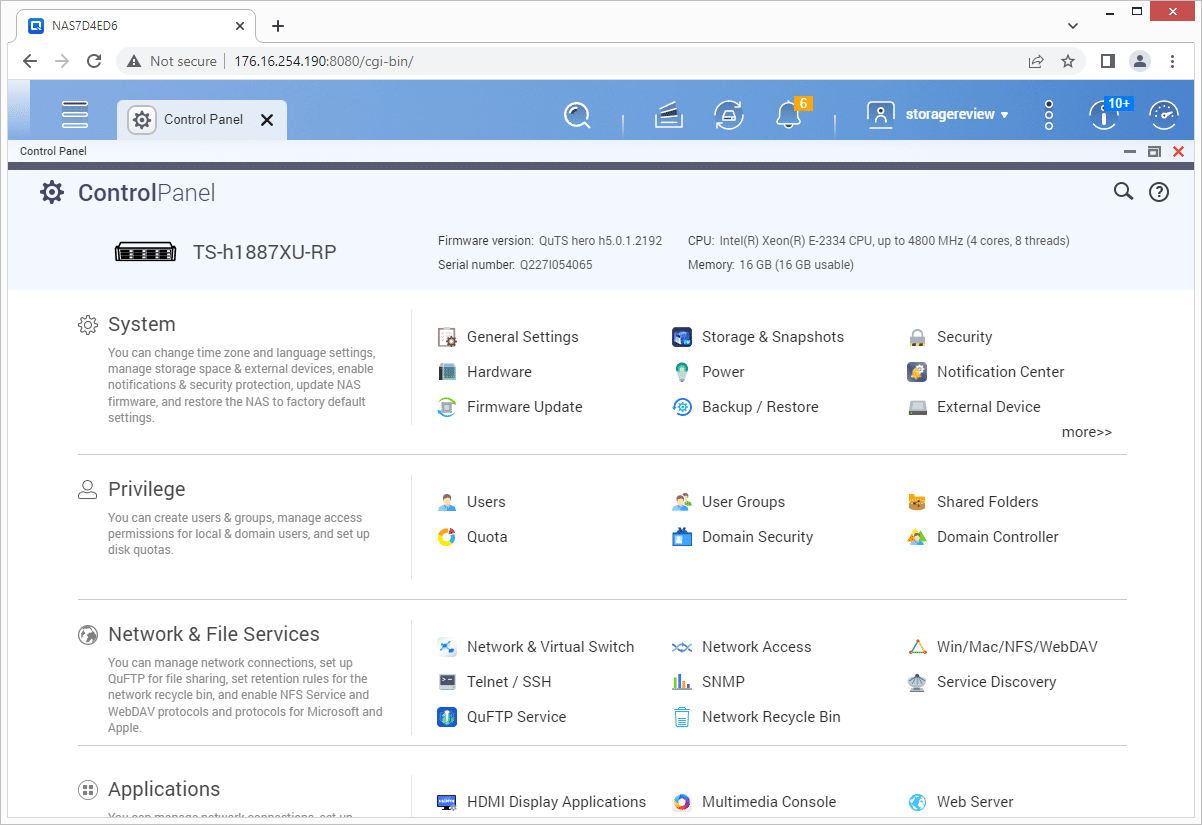
WD Red Pro HDDs are a line of high-capacity hard drives designed for use in NAS systems up to 24 bays. These hard drives are optimized for multi-user environments and can handle high-intensity workloads in 24×7 environments. They are ideal for storing, protecting, archiving, and sharing large amounts of data, and can be used for various data-intensive applications. For the testing here, these drives are ideal for bulk storage. These drives cost about $550 on Amazon.
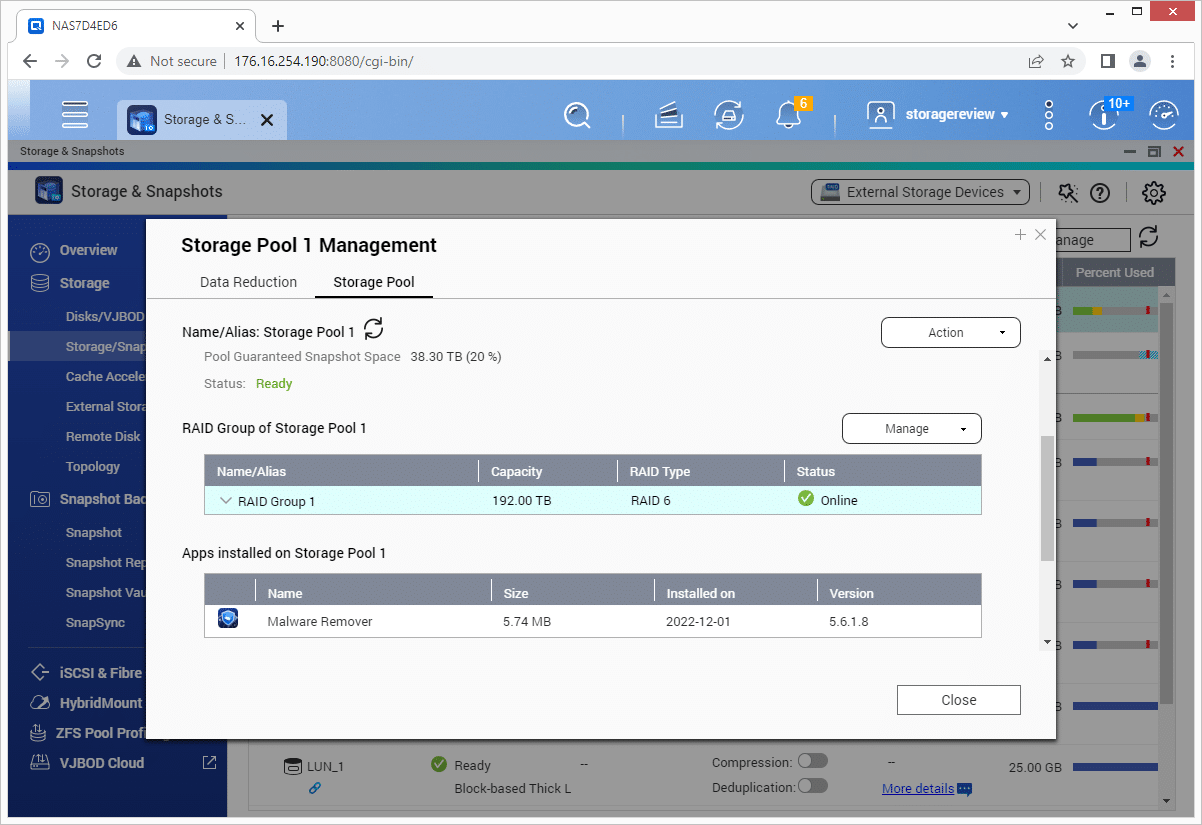
The WD Red SA500 SSD is intended to be used as a caching solution in NAS systems, offering enhanced performance and faster access to data. In this case, though we’re using them as a flash volume. Either way, these SSDs are designed to help minimize performance bottlenecks and improve the overall efficiency of NAS systems. Being SATA, they’re also cost-effective, street pricing is about $380.
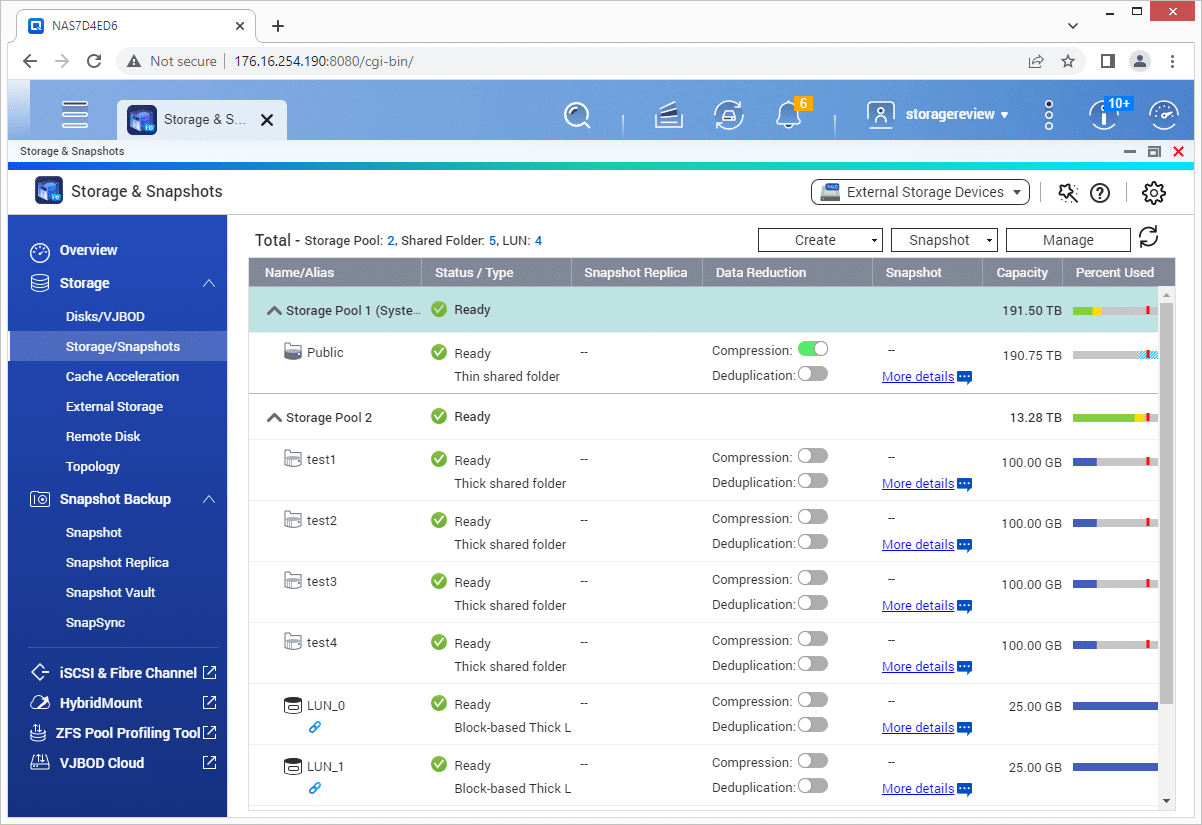
QNAP TS-h1887XU-RP Performance
For this review, we are using 12 x 22TB WD Red Pro in RAID6 and 6 x 4TB WD Red SSD in RAID6.
Our enterprise NAS testing process preconditions each drive-set into steady-state with the same workload the device will be tested with under a heavy load of 16 threads, with an outstanding queue of 16 per thread. The device is then tested in set intervals in multiple thread/queue depth profiles to show performance under light and heavy usage. Since hard drives reach their rated performance level very quickly, we only graph out the main sections of each test.
Preconditioning and Primary Steady-State Tests:
- Throughput (Read+Write IOPS Aggregate)
- Average Latency (Read+Write Latency Averaged Together)
- Max Latency (Peak Read or Write Latency)
- Latency Standard Deviation (Read+Write Standard Deviation Averaged Together)
Our Enterprise Synthetic Workload Analysis includes three profiles based on common workload sizes. These profiles have been developed to make it easier to compare to our past benchmarks, as well as widely-published values such as max 4K read and write speed and 8K 70/30, which is commonly used for storage devices. When testing NAS platforms, for each storage pool we benchmark, we provision four shared folders for 25GB files and four 25GB iSCSI luns.
4K
- 100% Read or 100% Write
- 100% 4K
8K 70/30
- 70% Read, 30% Write
- 100% 8K
128K (Sequential)
- 100% Read or 100% Write
- 100% 128K
Our first throughput test measures 4K random performance of the QNAP TS-h1887XU-RP. Here, it posted similar performance in iSCSI and SMB configurations. In SSD performance, it showed 45,543 IOPS in reads and 17,735 IOPS write (SMB) and 44,448 IOPS read and 17,891 IOPS write (iSCSI). In HDD performance, the TS-h1887XU-RP recorded 1,878 IOPS read and 1,882 IOPS write (SMB) and 2831 read and 2350 IOPS write (iSCSI).
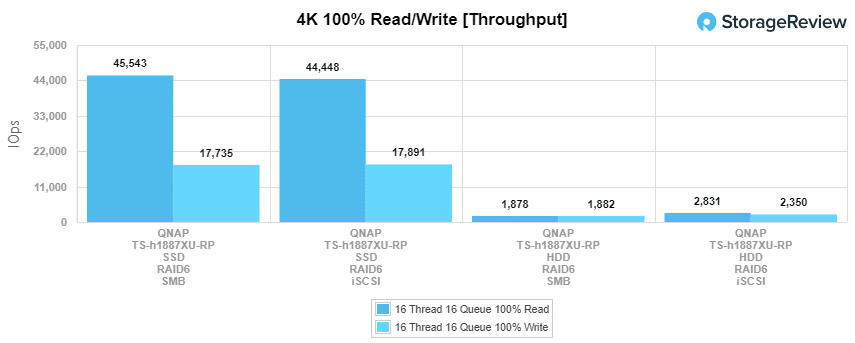
In average latency, the TS-h1887XU-RP recorded similar performance in SMB and iSCSI again. For SSD performance, it posted read and writes of 5.62ms and 14.43ms (SMB) and 5.76ms and 14.31ms (iSCSI SSD). For the HDD configuration, the TS-h1887XU-RP had 136.26ms read and 135.93ms write, and 90.40ms read and 108.89ms write.
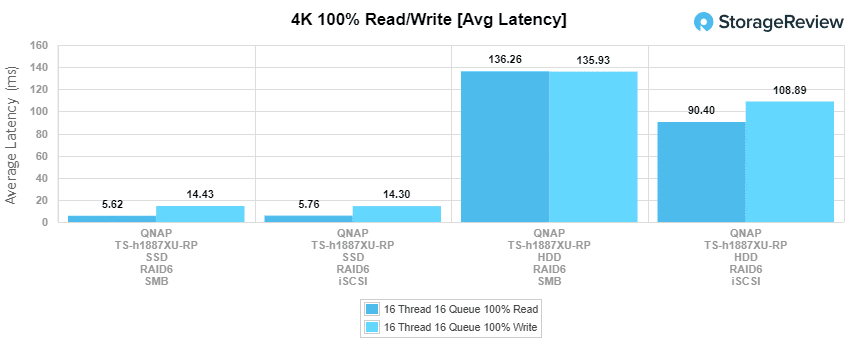
Moving on to the max latency, the TS-h1887XU-RP started to show better performance using SMB, as it posted 239.30ms read and 376.51ms write (SSD) and 404ms read and 894ms write (HDD).
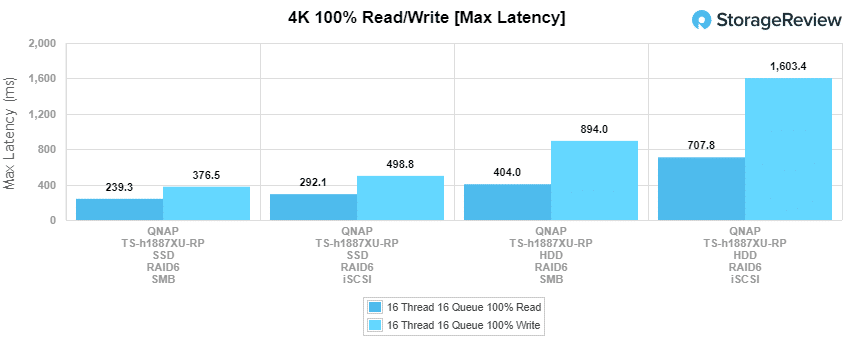
For standard deviation, the TS-h1887XU-RP recorded 40ms read and 1,075.1ms write in SMB, and 44.86ms read and 203.95ms write in iSCSI with our SSD RAID6 config. Looking at the HDD setup, it posted 404ms read and 894ms write (SMB) and 707.8ms read and 1,603.4ms write (iSCSI).
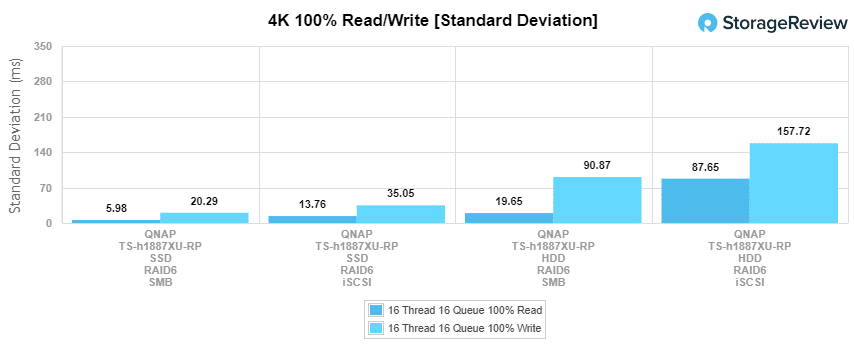
Our next benchmark subjects the drives to 100% read and write activity at 8K sequential throughput. Using the 22TB WD Red Pros inside the QNAP TS-h1887XU-RP, the performance showed 161334 IOPS read and 147,766 IOPS write in SMB, while reaching 19,1740 IOPS read and 217,042 IOPS write in iSCSI. Looking at the HDD configuration, it recorded 84,186 IOPS read and 154,793 IOPS write (SMB) and 111,386 IOPS read and 195,198 IOPS write (iSCSI).
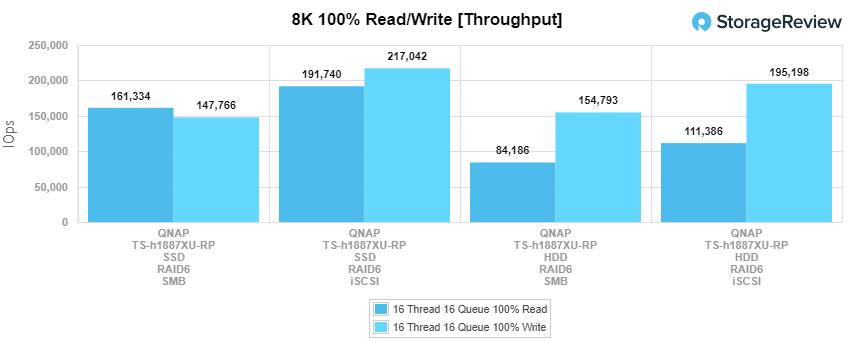
Our next test shifts focus from a pure 8K sequential 100% read/write scenario to a mixed 8K 70/30 workload, which will demonstrate how performance scales in a setting from 2T/2Q up to 16T/16Q.
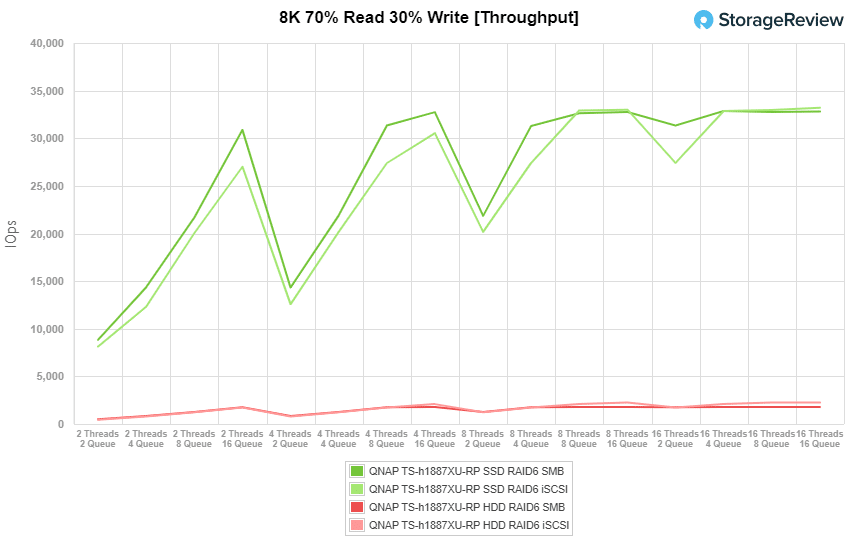
Up first is throughput, where the QNAP TS-h1887XU-RP had a range of 8,828 IOPS to 32,801 IOPS in SMB and 8,133 IOPS to 33,209 IOPS in iSCSI for our SSD configuration. For our HDD setup, it recorded a range of 500 IOPS to 1,778 IOPS (SMB) and 442 IOPS to 2,264 IOPS (iSCSI).
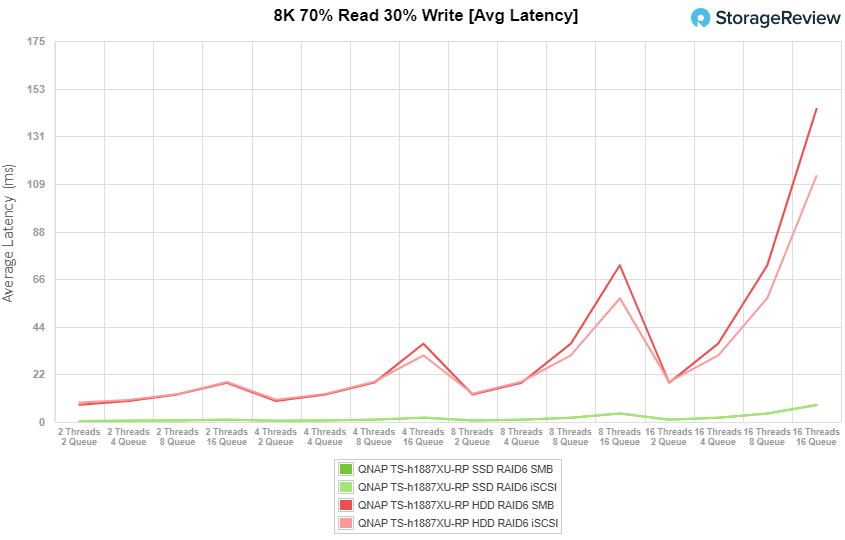
With average latency at 8K 70/30 the QNAP TS-h1887XU-RP showed very similar performance between the SSD SMB and iSCSI configurations posting a range of 0.45ms and 7.8ms, and 0.48ms to 7.7ms, respectively.
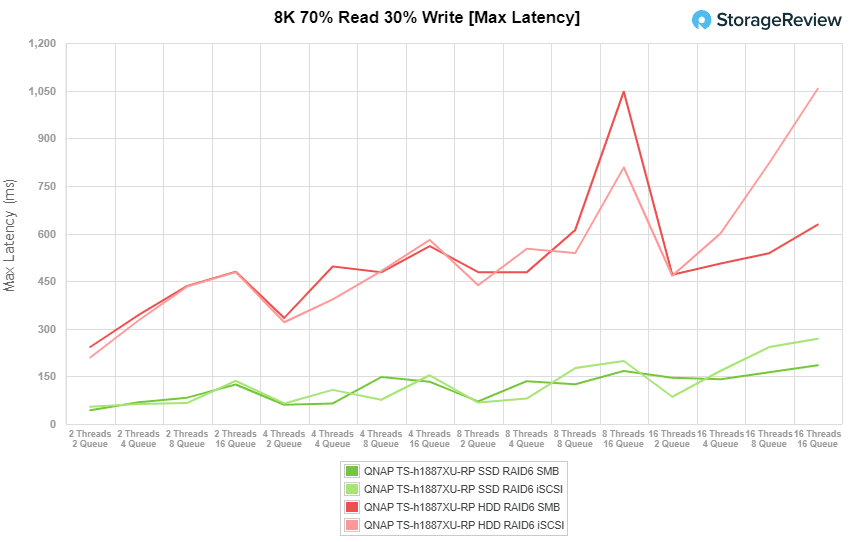
In max latency, the QNAP TS-h1887XU-RP showed its best performance with SMB, where it showed a range of 43.15ms and 185.13ms (SSDs) and 7.97ms and 143.8ms (HDDs).
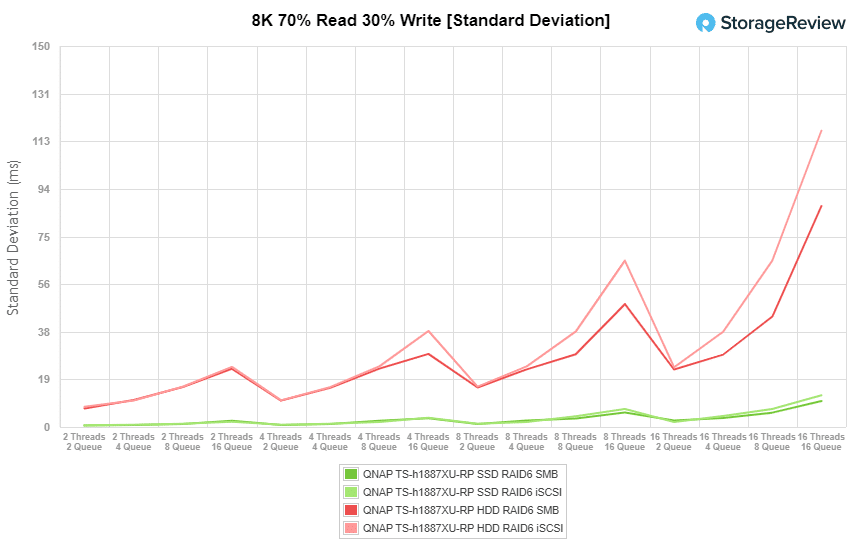
For standard deviation latency, results were a bit closer, posting a range of 0.57ms to 10.21ms (SMB) and 0.66 to 12.48ms (iSCSI) for our SSD configuration. Looking at HDDs, the TS-h1887XU-RP recorded ranges of 7.31ms to 86.97ms (SMB) and 7.95ms to 116.63ms (iSCSI).
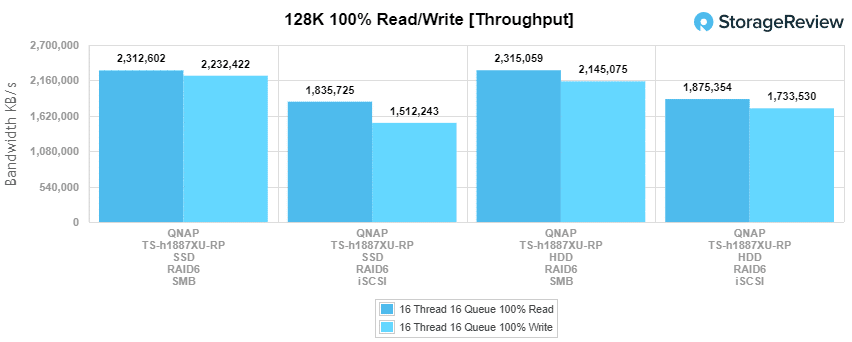
Our last test is the 128K benchmark, a large-block sequential test showing the highest sequential transfer speed. For our SSD configuration, the QNAP TS-h1887XU-RP posted 2.31GB/s read and 2.23GB/s write in SMB, while iSCSI recorded 1.84GB/s read and 1.51GB/s write. With HDDs, the TS-h1887XU-RP showed 2.32GB/s read and 2.14GB/s write, while iSCSI recorded 1.88GB/s read and 1.73GB/s write.
Final Thoughts
The QNAP TS-hx87XU-RP is part of a versatile line of NAS solutions that integrates Intel Xeon E-2300 processors, 10GbE and 2.5GbE Multi-Gig connectivity, and HDD/SSD hybrid storage architecture. Coupled with its range of different available sizes, including 9, 18, 22, and 30-bay models, this QNAP NAS line is a great solution that can balance performance, capacity, and cost depending on your needs.
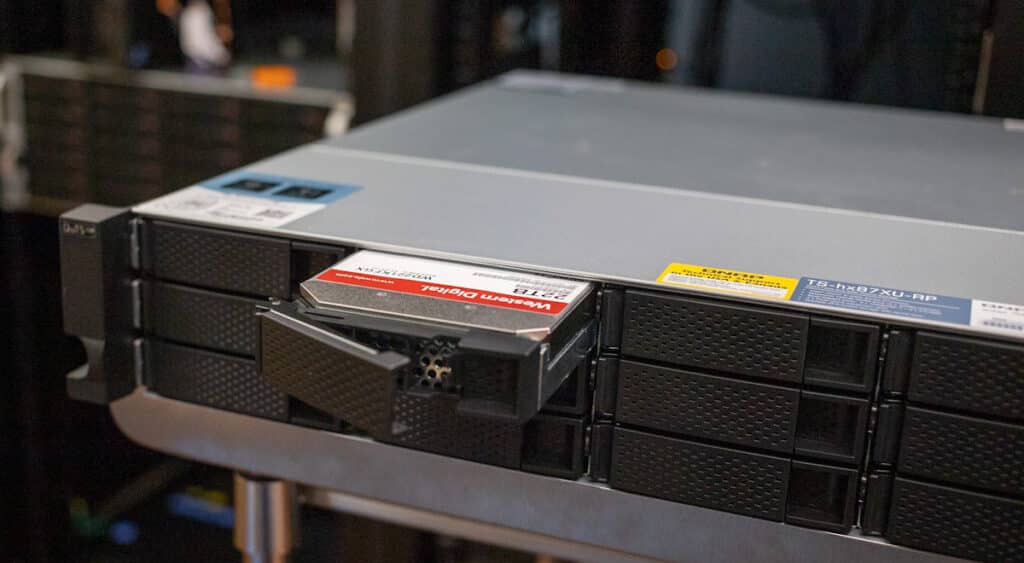
We looked at the 2U 18-bay model for this review, which features 12x 3.5″ HDD bays in the front and 6x 2.5″ SATA bays in the back. Powered and managed by the QTS or QuTS hero operating systems TS-hx87XU-RP is an ideal storage solution for businesses, with applications in file servers, virtualization servers, VDI, and backup/restore.
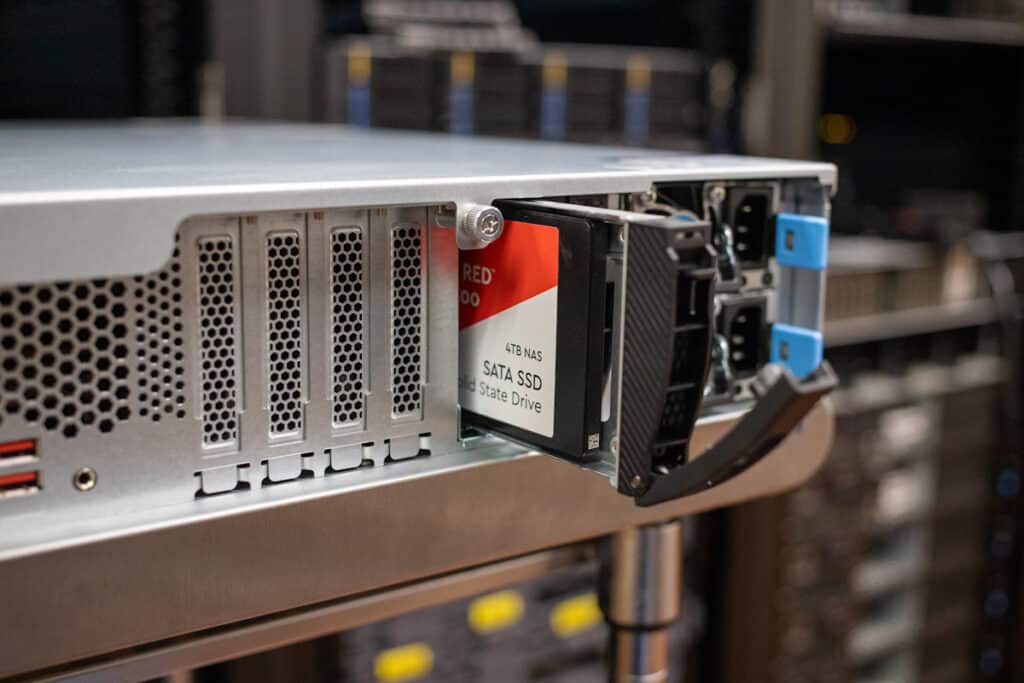
Our specific model is the TS-h1887XU-RP-E2334-16G, equipped with an Intel Xeon E-2334 CPU (4C/8T 3.4GHz, up to 4.8GHz) and 16GB ECC of DDR4 RAM (1 x 16GB). To see what it can do regarding performance, we looked at both HDD (12 x 22TB WD Rep Pro in RAID6) and SSD caching (6 x 4TB WD Red SSD in RAID6) configurations using both SMB and iSCSI connectivity. In our 100% read/write random 4K performance test, we saw 45,543 IOPS in reads and 17,735 IOPS write (SMB) and 44,448 IOPS read and 17,891 IOPS write (iSCSI) with SSD cache enabled. In HDD-only performance, the TS-h1887XU-RP recorded 1,878 IOPS read and 1,882 IOPS write (SMB) and 2,831 read and 2,350 IOPS write (iSCSI).
During our 8K sequential throughput tests, we saw 161K IOPS read and 148K IOPS write in SMB, while reaching 192K IOPS read and 217K IOPS write in iSCSI with SSD cache enabled. Looking at the HDD-only configuration, the TS-hx87XU-RP was able to hit 84K IOPS read and 155K IOPS write (SMB) and 111K IOPS read and 195K IOPS write (iSCSI).
In our large-block sequential test, the TS-hx87XU-RP posted 2.31GB/s read and 2.23GB/s write in SMB, while iSCSI recorded 1.84GB/s read and 1.51GB/s write with SSD cache enabled. In our HDD-only config, we saw 2.32GB/s read and 2.14GB/s write, while iSCSI recorded 1.88GB/s read and 1.73GB/s write.
When it comes to complete NAS solutions, QNAP has been a long-time favorite of ours because of its hardware decisions. Giving customers 2.5GbE, 10GbE. several PCIe slots and six SATA bays on the back makes this an extremely flexible platform for SMBs. The hardware platform coupled with ZFS underneath (QuTS hero), should also provide peace of mind when it comes to data integrity and data services.
Engage with StorageReview
Newsletter | YouTube | Podcast iTunes/Spotify | Instagram | Twitter | TikTok | RSS Feed

